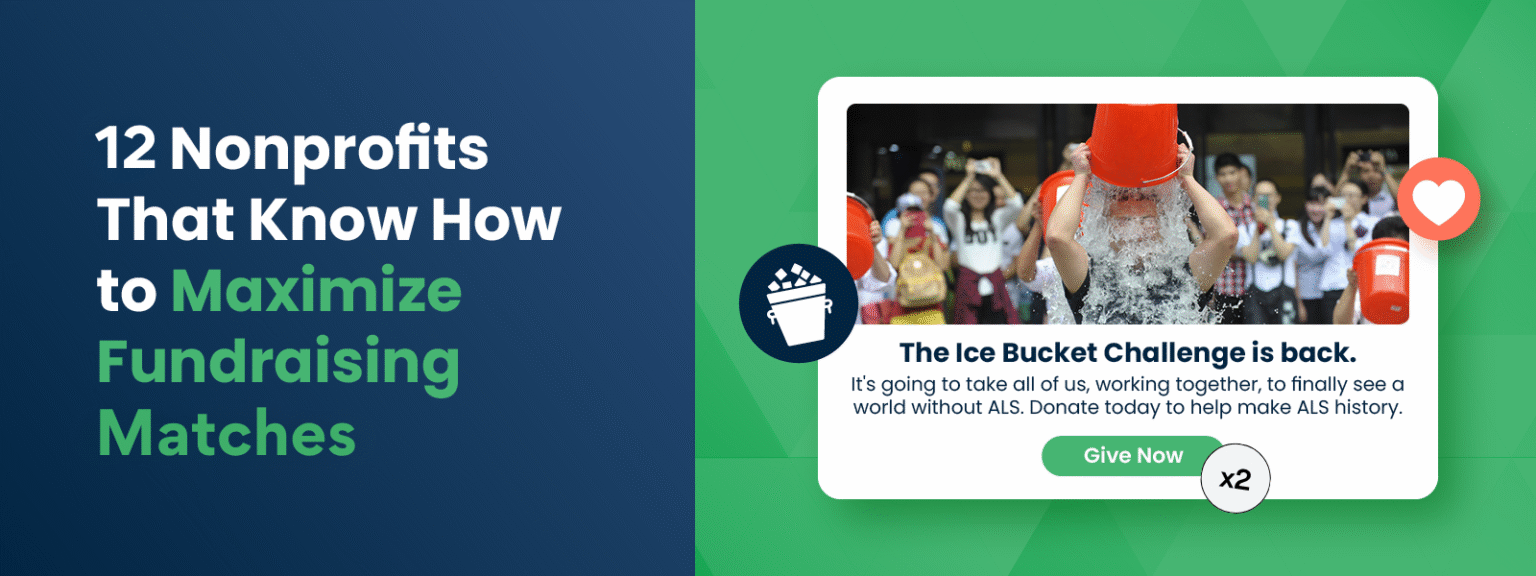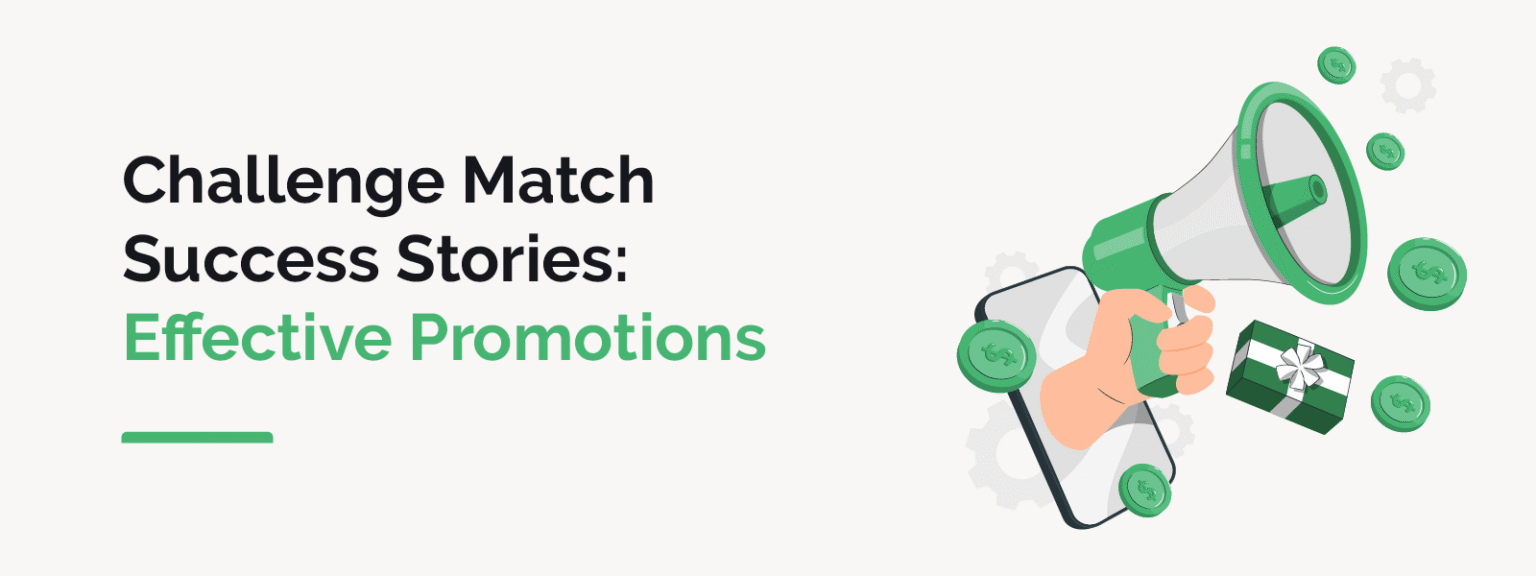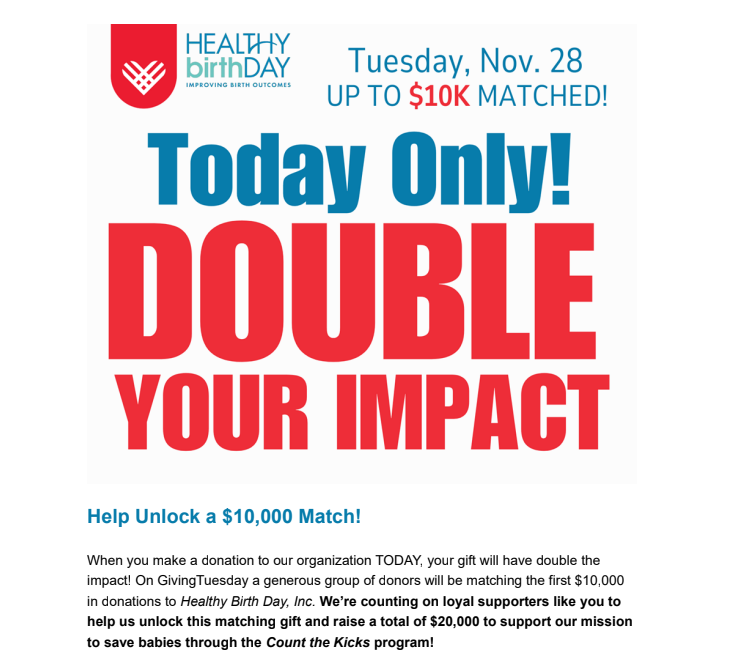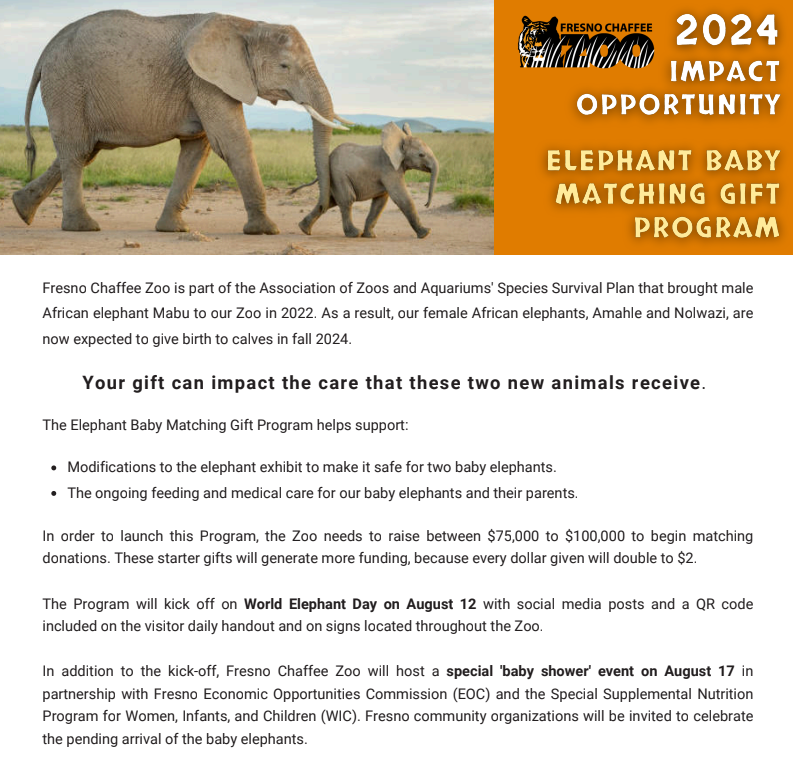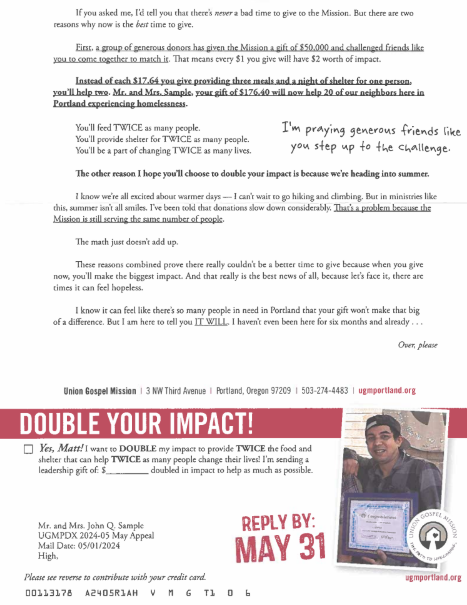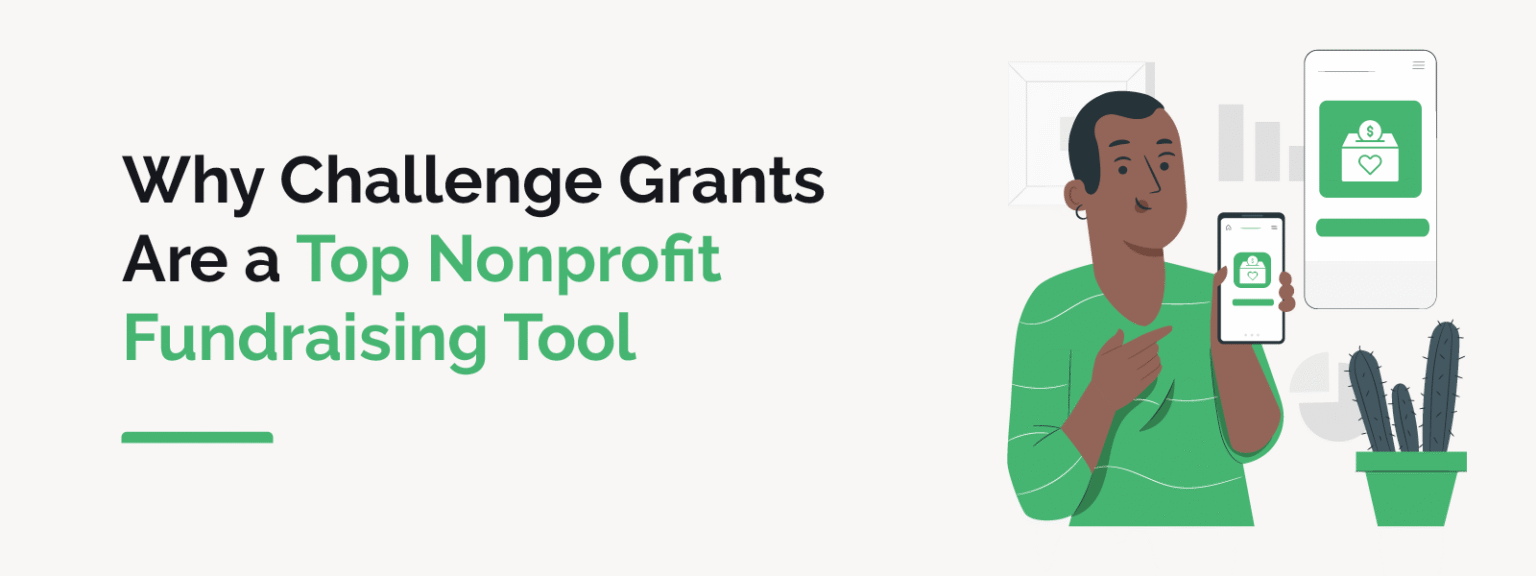7 Challenge Match Success Stories: Effective Promotions
/in Challenge Grants, Learning Center, Lists and Rankings /by Adam WeingerChallenge match campaigns are a powerful fundraising tool for nonprofits looking to drive donor engagement and boost donations. By offering to match contributions, organizations create a sense of urgency and excitement among supporters. These campaigns motivate donors by showing them that their gift will have an even greater impact.
In this post, we’ll highlight seven nonprofits that ran successful challenge match campaigns:
- Healthy Birthday
- UOAA
- Fresno Chaffee Zoo
- Union Gospel Mission
- Sofia’s Hope
- Humane Animal Rescue of Pittsburgh
- UWC-USA
By sharing these organizations’ top strategies, promotions, and results, we hope to inspire your next challenge match campaign and provide you with actionable insights to increase engagement and funding for your cause.
Healthy Birthday
Nonprofit website: https://healthybirthday.org/
Healthy Birthday, a nonprofit focused on supporting children’s health and wellness, capitalized on Giving Tuesday by launching a $10,000 matching grant appeal. To maximize engagement, they added a series of incentives for donors. These included a free spa gift certificate for those who gave a specific amount, as well as a branded t-shirt for donors who raised a certain amount through peer-to-peer fundraising.
The combination of a matching gift, a clear goal, and intriguing incentives proved to be a highly effective promotional strategy. Here’s what made Healthy Birthday’s campaign stand out:
- Engaging incentives: The addition of spa gift certificates and t-shirts incentivized higher donation amounts and encouraged peer-to-peer fundraising.
- Use of Giving Tuesday: Tying the campaign to Giving Tuesday helped leverage the global giving momentum, which is vital for short-term fundraising success.
- Social media push: They promoted the campaign across multiple social media platforms, increasing visibility and encouraging wider participation.
For your own campaign, adding value through fun incentives can significantly boost both engagement and total funds raised.
UOAA
Nonprofit website: https://www.ostomy.org/
In the Fall of 2023, the United Ostomy Associations of America (UOAA) launched a Matching Donor Program that aimed to raise $50,000. With a generous anonymous donor matching all gifts, UOAA exceeded their goal by $10,000, bringing in a total of $60,000.
UOAA’s campaign benefited from several key promotional tactics:
- Clear and consistent messaging: They communicated the matching opportunity clearly through email and social media posts, ensuring donors knew exactly how their contributions would be doubled.
- Strategic donor relationships: The nonprofit built a relationship with a matching donor who was deeply invested in the cause, making it easier to secure a significant donation.
- Tight timeline: The campaign was time-limited, creating a sense of urgency that encouraged immediate action from donors.
For nonprofits looking to replicate this success, consider securing a major donor or corporate partner to provide a match. Make sure the match is clearly communicated and the timeline is well-promoted.
Fresno Chaffee Zoo
Nonprofit website: http://fcz.org/
Fresno Chaffee Zoo launched the Elephant Baby Matching Gift Program, aimed at supporting two African elephants expected to give birth in 2024. The program needed to raise between $75,000 and $100,000 to kick-start matching donations, with every dollar donated being matched to double the impact.
To promote the campaign, the Zoo utilized a mix of methods:
- Kickoff event: They began the campaign on World Elephant Day with social media posts, QR codes, and visitor handouts at the zoo.
- In-person events: A special ‘baby shower’ event was held to generate excitement, featuring community partners like the Fresno Economic Opportunities Commission.
- QR codes and easy donation access: QR codes throughout the zoo and event materials made it easy for donors to quickly contribute while on-site.
This multifaceted promotional strategy combined events, online engagement, and clear, impactful visuals to successfully generate support for the elephant babies.
Union Gospel Mission
Nonprofit website: https://ugmportland.org/
Union Gospel Mission in Portland launched a matching campaign with a $50,000 gift from a group of generous donors. The mission emphasized how each dollar donated would have twice the impact, helping to feed and shelter twice as many people.
This campaign was especially effective due to:
- Compelling, donor-focused messaging: The organization clearly communicated the life-changing impact of donations, making it easy for donors to see the direct effect of their contributions.
- Seasonal urgency: The timing of the campaign, in the run-up to summer when donations typically slow down, helped encourage donors to act immediately.
- Personalized outreach: Their appeal, including personal testimonials, created a deeper connection with the mission and its supporters.
Nonprofits can replicate this by highlighting the difference that donations make in people’s lives and emphasizing the urgency of giving during slower months.
Sofia’s Hope
Nonprofit website: https://www.sofiashope.org/
Sofia’s Hope, a nonprofit focused on childhood cancer, ran multiple successful matching campaigns, including one during their Summer and End of Year appeals. They secured corporate sponsors to match all donations up to $5K in the summer and $10K for the end-of-year campaign.
They also held a Round Up Campaign at a local restaurant in September for Childhood Cancer Awareness Month, where all funds raised were matched by the restaurant.
What made Sofia’s Hope successful:
- Corporate partnerships: They leveraged corporate matching gifts to significantly increase donations, with the added bonus of matching from local businesses.
- Community involvement: The Round Up Campaign created a community-driven fundraising effort that engaged both local businesses and the public.
- Multiple fundraising channels: They marketed the campaign through social media, text messaging, and e-blasts, ensuring a wide reach.
For nonprofits looking to replicate this success, focusing on local partnerships and corporate matches can enhance your fundraising efforts.
Humane Animal Rescue of Pittsburgh
Nonprofit website; https://humaneanimalrescue.org/
Humane Animal Rescue of Pittsburgh (HARP) used matching gifts to boost recurring donations in June. Donors who committed to becoming monthly supporters through the HARP 365 program had their first two monthly gifts doubled by Fetch Pet Insurance.
This campaign was effective because:
- Emphasis on recurring gifts: Focusing on long-term support rather than one-time donations helped build a steady stream of income.
- Corporate partnership: Fetch Pet Insurance was a natural partner for HARP, aligning with their mission and creating a strong donor engagement opportunity.
- Clear, ongoing impact: By highlighting the value of recurring donations, HARP was able to convert one-time donors into long-term supporters.
For your organization, building corporate partnerships for monthly giving matches is a great way to ensure sustained funding.
UWC-USA
Nonprofit website: https://www.uwc-usa.org/
UWC-USA leveraged corporate matching gifts in their campaigns, particularly during events like Giving Tuesday. By reaching out to alumni and supporters who worked at companies with matching gift programs, they were able to increase donations by around 30%.
Key strategies included:
- Targeted outreach: They identified potential donors who worked for companies with matching gift programs and sent them tailored emails to encourage participation.
- Promoting corporate matches: Once supporters were on the donation page, they were encouraged to check their eligibility for corporate matching gifts, increasing the chances of participation.
- Leveraging Giving Tuesday: By linking the campaign to a popular giving day, UWC-USA maximized visibility and donor engagement.
To replicate this strategy, use donor data to identify matching gift opportunities and promote them through targeted emails or text messages.
Wrapping Up & Next Steps
Challenge match campaigns are a proven way to increase donations and engage supporters in a meaningful way. By looking at the success stories of nonprofits like these, you can gain insights into how to run your own effective matching campaigns.
Use the strategies discussed here to inspire your next effort, and remember: with the right messaging, strategic partnerships, and powerful promotions, your challenge match can have an incredible impact on your fundraising goals.
Raise Even More with Employee Matching Gifts!
In addition to challenge grants, employee matching gifts offer another excellent opportunity for raising funds. With Double the Donation, your nonprofit can easily identify matching gift opportunities and track progress to maximize the impact of these funds. Start raising more today by integrating employee matching gifts into your campaigns! Request a demo today to get started.
How to Identify Challenge Grant Donors for Your Nonprofit
/in Learning Center, Challenge Grants /by Adam WeingerDebunking Common Myths About DAFs in Challenge Matches
/in Challenge Grants, Learning Center /by Adam WeingerHow to Use Your Website to Track Challenge Grant Progress
/in Challenge Grants, Learning Center /by Sydney FayeHow to Create Urgency + Make Your Challenge Match Stand Out
/in Challenge Grants, Learning Center /by Adam WeingerNonprofits are always looking for innovative ways to engage donors and maximize their fundraising potential. Challenge matches are among the most effective strategies available, driving increased donations by creating urgency, doubling the impact of each gift, and motivating supporters to contribute. However, to fully harness the power of challenge grants and matches, nonprofits must engage donors effectively before, during, and after the campaign.
In this blog post, we’ll explore how to source interested donors, communicate with them effectively, and make the match process seamless. By following these strategies, your nonprofit can increase donor participation, track real-time progress, and ultimately raise more funds for your cause.
- Understanding Challenge Matches
- Sourcing Interested Donors for Challenge Grants
- Communicating with Donors: Keeping Them Informed
- Best Practices for Engaging Donors Throughout the Campaign
Understanding Challenge Matches
A challenge grant is a fundraising initiative in which a donor (or organization) pledges to match the funds raised by the nonprofit during a specific period. The most common type of challenge grant is a 1:1 match, meaning the donor matches every dollar raised by the nonprofit. These grants are typically time-sensitive, encouraging donors to give quickly to meet the fundraising goal.
By engaging donors effectively, these campaigns can raise significant amounts of money in a short time. However, to see maximum results, nonprofits must focus on targeting the right donors and making the process as simple and transparent as possible.
Sourcing Interested Donors for Challenge Grants
One of the first steps in running a successful challenge grant campaign is locating the right donors to participate. Luckily, your website is one of the most powerful tools at your disposal for identifying engaged donors. By analyzing how visitors interact with your website, you can identify individuals who are already interested in your mission and who may be inclined to contribute to your challenge match campaign.
Start by tracking key website actions such as:
- Donations: Visitors who have already donated are your most likely candidates for challenge grants. Review past donation data to see who has given at higher levels or made multiple contributions.
- Event Participation: If your nonprofit hosts events, track attendees who engage deeply with your content or share your mission. They may be prime candidates for becoming a match donor.
- Content Engagement: Track which visitors are spending time on high-impact pages (like your mission page, programs, or donation page). Those who engage with your cause are more likely to donate.
Communicating with Donors: Keeping Them Informed
Engaging donors throughout the campaign is essential to maintaining momentum and ensuring they stay involved in the process. Donors need to understand how their contributions are contributing to the overall goal and how their donations will be matched.
Real-Time Updates: Progress Bars and Countdown Timers
One of the best ways to engage donors and keep them informed is through real-time updates. This can be done using progress bars and countdown timers on your website.
- Progress Bars: Displaying a fundraising thermometer or progress bar on your donation page allows donors to see how close the campaign is to meeting the challenge match goal. This motivates donors to act quickly, especially as the goal nears.
- Countdown Timers: A visible countdown timer can create urgency by reminding donors that there is a limited amount of time to take advantage of the matching funds. The clock ticking down encourages donors to act before the opportunity ends.
These tools not only keep your donors informed but also encourage further engagement. As the match deadline approaches, donors may increase their contributions to help meet the goal, knowing their gift will be matched.
Transparency: Explaining the Impact of Their Donations
Donors want to know how their contributions are being used and the impact they will have. Be sure to explain exactly how the matching funds will support your cause. Whether it’s funding a specific program or helping meet a broader organizational goal, donors need to understand the direct effect of their gift.
Use stories and testimonials that connect their contribution to tangible outcomes. The more transparent you are about the impact of the funds raised, the more likely donors will feel motivated to give.
Best Practices for Engaging Donors Throughout the Campaign
Here are some best practices for keeping donors engaged and motivated throughout the challenge match, making your campaign stand out:
1. Regular Updates and Milestone Announcements
One of the most powerful tools for keeping your donors engaged throughout a challenge match campaign is consistent communication. Providing regular updates ensures that donors feel involved and see the progress of the campaign. It’s crucial to send out updates via multiple channels, such as email, social media, and your nonprofit’s website.
Updates can include key milestones like when the campaign has reached 50% of the goal, how much is left to unlock the match, or when you’re just a few donations away from hitting a target. These announcements not only keep donors informed but also reignite their excitement and encourage them to contribute again.
When donors see that their contributions are making a real impact, they are more likely to increase their giving or share the campaign with their networks. Timely and transparent updates build a sense of community and create a collective effort to achieve the campaign’s goals.
2. Acknowledge Donors Promptly
Acknowledging donors promptly is crucial for fostering a deeper connection to your nonprofit and campaign. As soon as a donation is made, it’s essential to thank the donor personally, whether through a thank-you email, a phone call, or a thank-you card. Personalized messages that highlight the donor’s specific contribution—such as how their donation will help unlock matching funds—help make the donor feel valued.
The acknowledgment should also reiterate the impact of their gift, letting them know that their support is making a meaningful difference. Recognizing their generosity promptly not only shows gratitude but also reinforces the importance of their role in the campaign. It builds trust and encourages further participation, fostering long-term relationships that are vital for future campaigns.
3. Recognize Donors Publicly
Public recognition is a key component of donor engagement. Recognizing your donors publicly, especially major donors or those who contribute large sums, helps to build goodwill and increase their satisfaction with the campaign. Publicly thanking your donors on social media, in email campaigns, and on your website allows others to see the impact of the contributions, creating a sense of pride and accomplishment for the donors.
It also serves as a form of social proof, encouraging others to contribute when they see their peers being recognized for their support. Acknowledging donors publicly can be done through a donor wall on your website, shout-outs on social media platforms, or even at donor recognition events. This public recognition shows your appreciation and encourages others to get involved, knowing they, too, will be acknowledged for their contributions.
4. Maintain Transparency and Trust
Maintaining transparency throughout a challenge match campaign is critical for building trust and fostering donor loyalty. Donors need to understand how their contributions are helping to meet the campaign’s goals. By providing clear and consistent updates on how much has been raised, how close the campaign is to reaching its target, and how much time is left, you ensure that donors remain confident in the process.
Transparency also involves clearly explaining how the matching funds work, where the money is going, and the tangible impact it will have. This openness encourages donors to stay engaged, as they feel assured that their money is being used wisely. Transparency also builds credibility and trust, which are essential for cultivating long-term relationships with donors. Regular updates with accurate and honest information about campaign progress will keep donors motivated and excited about being part of the campaign.
Wrapping Up & Next Steps
Engaging donors in challenge grants and challenge matches is essential for maximizing your nonprofit’s fundraising efforts. By using real-time updates, simplifying the matching process, and maintaining transparent communication, you can keep your donors involved and motivated throughout the campaign.
To ensure success:
- Leverage your website and digital tools to keep donors informed.
- Simplify the donation and matching process using automated tools.
- Engage donors consistently with progress updates and recognition.
By following these strategies, your nonprofit can effectively engage donors, maximize the impact of challenge grants, and ultimately raise more funds to support your mission.
Raise Even More with Employee Matching Gifts!
In addition to challenge grants, employee matching gifts can further boost your fundraising efforts. With Double the Donation, your nonprofit can easily identify matching gift opportunities and streamline the process. Start raising more today by integrating employee matching gifts into your campaigns! Get a free demo of Double the Donation to see how our tools can help.
How to Engage Donors in Challenge Grants, Challenge Matches
/in Challenge Grants, Learning Center /by Sydney FayeNonprofits are always looking for innovative ways to engage donors and maximize their fundraising potential. Challenge grants and challenge matches are among the most effective strategies available, driving increased donations by creating urgency, doubling the impact of each gift, and motivating supporters to contribute. However, to fully harness the power of challenge grants and matches, nonprofits must engage donors effectively before, during, and after the campaign.
In this blog post, we’ll explore how to source interested donors, communicate with them effectively, and make the match process seamless. We’ll cover how to use website engagement, employment data, and donor tracking tools to identify and engage the right donors for challenge match campaigns. By following these strategies, your nonprofit can increase donor participation, track real-time progress, and ultimately raise more funds.
- Understanding Challenge Grants and Challenge Matches
- Sourcing Interested Donors for Challenge Grants
- Communicating with Donors: Keeping Them Informed
- Making it Easy for Donors to Issue Their Grants
- Best Practices for Engaging Donors Throughout the Campaign
Understanding Challenge Grants and Challenge Matches
Before diving into how to engage donors, it’s important to define what challenge grants and challenge matches are and why they are so effective for nonprofits.
Challenge Grants:
A challenge grant is a fundraising initiative in which a donor (or organization) pledges to match the funds raised by the nonprofit during a specific period. The most common type of challenge grant is a 1:1 match, meaning the donor matches every dollar raised by the nonprofit. These grants are typically time-sensitive, encouraging donors to give quickly to meet the fundraising goal.
Challenge Matches:
A challenge match is similar to a challenge grant, but it focuses on matching contributions rather than offering a lump sum at the end. For example, a corporate sponsor might agree to match donations up to $100,000 during a two-week campaign.
Both challenge grants and challenge matches work by creating a sense of urgency, motivating donors to contribute more. The match component encourages people to give, knowing their contribution will be doubled, tripled, or more. The deadline aspect inspires donors to act fast.
By engaging donors effectively, these campaigns can raise significant amounts of money in a short time. However, to see maximum results, nonprofits must focus on targeting the right donors and making the process as simple and transparent as possible.
Sourcing Interested Donors for Challenge Grants
One of the first steps in running a successful challenge grant campaign is identifying the right donors to participate. Targeting engaged individuals on your website and using data to identify potential contributors are essential for sourcing donors who are most likely to participate in your campaign.
Your website is one of the most powerful tools at your disposal for identifying engaged donors. By analyzing how visitors interact with your website, you can identify individuals who are already interested in your mission and who may be inclined to contribute to your challenge match campaign.
Start by tracking key website actions such as:
- Donations: Visitors who have already donated are your most likely candidates for challenge grants. Review past donation data to see who has given at higher levels or made multiple contributions.
- Event Participation: If your nonprofit hosts events, track attendees who engage deeply with your content or share your mission. They may be prime candidates for becoming a match donor.
- Content Engagement: Track which visitors are spending time on high-impact pages (like your mission page, programs, or donation page). Those who engage with your cause are more likely to donate.
Communicating with Donors: Keeping Them Informed
Engaging donors throughout the campaign is essential to maintaining momentum and ensuring they stay involved in the process. Donors need to understand how their contributions are contributing to the overall goal and how their donations will be matched.
Real-Time Updates
One of the best ways to engage donors and keep them informed is through real-time updates. This can be done using…
- Progress Bars: Displaying a fundraising thermometer or progress bar on your donation page allows donors to see how close the campaign is to meeting the challenge match goal. This motivates donors to act quickly, especially as the goal nears.
- Countdown Timers: A visible countdown timer can create urgency by reminding donors that there is a limited amount of time to take advantage of the matching funds. The clock ticking down encourages donors to act before the opportunity ends.
These tools not only keep your donors informed but also encourage further engagement. As the match deadline approaches, donors may increase their contributions to help meet the goal, knowing their gift will be matched.
Transparency
Donors want to know how their contributions are being used and the impact they will have. Be sure to explain exactly how the matching funds will support your cause. Whether it’s funding a specific program or helping meet a broader organizational goal, donors need to understand the direct effect of their gift.
Use stories and testimonials that connect their contribution to tangible outcomes. The more transparent you are about the impact of the funds raised, the more likely donors will feel motivated to give.
Making it Easy for Donors to Issue Their Grants
Once your donors are engaged and ready to contribute, the next step is making it as easy as possible for them to contribute their grants.
In order to do so, you’ll want to ensure that your donation page is user-friendly and optimized for quick donations. Provide clear instructions on how donors can make their contribution and issue a match.
For donors who are contributing through their DAFs (Donor Advised Funds), provide step-by-step instructions on how they can direct their fund to your nonprofit and recommend grants for matching. This makes the process seamless for them and ensures they are engaged throughout the entire campaign.
Best Practices for Engaging Donors Throughout the Campaign
Here are some best practices for keeping donors engaged and motivated throughout the challenge match campaign:
1. Regular Updates and Milestone Announcements
Keep your donors informed by sending regular updates through email, social media, and on your website. Share milestones along the way, such as when you reach 50% of the goal or how much is left to unlock the match.
2. Acknowledge Donors Promptly
Thank your donors as soon as they contribute. Personalized thank-you messages, especially those that highlight the impact of their gift, will increase their connection to the campaign and encourage further engagement.
3. Recognize Donors Publicly
Public recognition can go a long way in building goodwill and encouraging more contributions. Thank your major donors on social media, in email campaigns, and on your website. Recognizing their support makes them feel valued and appreciated.
4. Maintain Transparency and Trust
Keep the match process transparent and consistent. Donors need to know how their gifts are contributing to the overall goal. Update them frequently on how close the campaign is to reaching its target and how much time is left.
Wrapping Up & Next Steps
Engaging donors in challenge grants and challenge matches is essential for maximizing your nonprofit’s fundraising efforts. By using real-time updates, simplifying the matching process, and maintaining transparent communication, you can keep your donors involved and motivated throughout the campaign.
To ensure success:
- Leverage your website and digital tools to keep donors informed.
- Simplify the donation and matching process using automated tools.
- Engage donors consistently with progress updates and recognition.
By following these strategies, your nonprofit can effectively engage donors, maximize the impact of challenge grants, and ultimately raise more funds to support your mission.
Raise More with Employee Matching Gifts!
In addition to challenge grants, employee matching gifts can further boost your fundraising efforts. With Double the Donation, your nonprofit can easily identify matching gift opportunities and streamline the process. Start raising more today by integrating employee matching gifts into your campaigns! Get a free demo of Double the Donation to see how our tools can help.
Why Challenge Grants Are a Top Nonprofit Fundraising Tool
/in Challenge Grants, Learning Center /by Adam WeingerFor nonprofit organizations, the challenge of raising enough funds to support their mission can often feel overwhelming. With limited resources and a growing need for innovative strategies, how can your nonprofit increase donor engagement and maximize fundraising potential? The answer lies in challenge grants—one of the most powerful and effective tools in nonprofit fundraising.
A challenge grant, also known as a matching grant, is a powerful fundraising strategy in which a donor or organization pledges to match contributions raised by a nonprofit, often within a set time frame. These campaigns leverage the power of matching funds to create urgency, increase participation, and ultimately boost donations.
But what makes challenge grants so effective? In this blog post, we’ll explore why challenge grants are such a successful tool for nonprofits, how they can drive engagement, and the incredible outcomes they create for fundraising campaigns.
- What is a Challenge Grant?
- Why Challenge Grants Work: The Psychological Impact on Donors
- How Challenge Grants Drive Increased Revenue
- The Benefits of Challenge Grants Beyond Financials
- How to Use Challenge Grants to Engage Donors
What is a Challenge Grant?
A challenge grant is a fundraising tactic where a donor (or group of donors) offers to match donations raised by the nonprofit organization, often up to a certain amount or during a specific period of time. For example, a donor may pledge to match $50,000 in donations made within 30 days.
Challenge grants are highly effective because they create a sense of urgency and motivate donors to act quickly, knowing their donations will be doubled or even tripled. This matching opportunity encourages both existing and new donors to contribute at higher levels, which ultimately leads to greater revenue for the nonprofit.
One of the most attractive elements of a challenge grant is that it encourages reciprocity. When donors know their contribution will be matched, they feel a stronger connection to the cause, increasing both the likelihood of donation and the size of their contributions.
In fact, research shows that 84% of donors are more likely to give when a matching gift is available, and 36% report that they would not have contributed without the matching opportunity (source: Double the Donation).
Why Challenge Grants Work: The Psychological Impact on Donors
Challenge grants are not just about financial incentives—they tap into the psychological factors that drive donor behavior. The prospect of having one’s contribution matched has a profound impact on how donors approach giving. Here’s why:
1. Amplification of Impact
The concept of a doubled donation resonates strongly with donors. When someone gives $100 and knows that their gift will be matched, they feel as though they’ve contributed $200. This sense of increased impact encourages donors to give larger amounts and motivates them to contribute sooner.
2. Urgency and Time Sensitivity
Challenge grants are typically time-bound, which creates a sense of urgency. Donors are more likely to act quickly when they know there’s a limited window to take advantage of the matching opportunity. Research shows that campaigns with deadlines see higher participation rates, as donors don’t want to miss out on the opportunity to have their contributions matched.
3. Social Proof and Donor Participation
The social influence of challenge grants also plays a key role. As the fundraising campaign progresses, seeing the total raised toward the challenge goal can motivate other donors to act. Donors often want to be part of a successful campaign and to see their contributions make a real difference. Progress tracking tools like real-time progress bars and fundraising thermometers can further enhance this sense of social proof and inspire more people to give.
How Challenge Grants Drive Increased Revenue
When implemented correctly, challenge grants can dramatically increase the amount of funds raised during a campaign. The structure of challenge grants inherently leads to higher donor participation and larger gifts.
1. Matching Gifts Multiply Contributions
The most obvious benefit of challenge grants is that they double (or more) the impact of each donation. When donors know their gift will be matched, they are more likely to give larger amounts, leading to a higher average donation. According to recent research, campaigns with matching opportunities raise 3-5 times more during peak giving seasons than those without.
2. Attracting New Donors
Challenge grants are a great way to attract new donors to your organization. The presence of a matching gift provides a compelling reason for first-time donors to contribute. This increased engagement helps build a larger donor base, leading to more long-term financial support.
3. Increased Donation Frequency
Challenge grants also encourage repeat donations. When donors contribute to a campaign and see that their gift has been matched, they are more likely to give again in the future. This cycle of giving builds a sustainable funding model and ensures that your nonprofit has access to ongoing support.
4. Higher Levels of Corporate Involvement
In addition to individual donors, corporate partners can also play a crucial role in challenge match campaigns. Challenge grants offer companies the opportunity to maximize their philanthropic impact and engage other donors in giving, too.
The Benefits of Challenge Grants Beyond Financials
While challenge grants are highly effective at raising funds, they offer several non-financial benefits that can have a lasting impact on your nonprofit:
1. Strengthened Relationships with Donors
When donors contribute to a campaign with a matching gift, they feel more connected to your cause. Challenge grants provide a platform for fostering deeper relationships with both new and existing donors. By giving them the opportunity to double their impact, you make them feel more engaged and invested in the success of your nonprofit.
2. Building Donor Loyalty
Challenge match campaigns can create a sense of community among your supporters. Donors are more likely to continue their support if they feel that their contributions are valued and have made a meaningful difference. This results in increased donor loyalty and higher retention rates.
3. Boosted Brand Awareness
When challenge grants are well-publicized, they can help raise awareness of your nonprofit’s work. Whether through social media, email campaigns, or newsletters, your challenge match campaign provides a great opportunity to showcase your mission and attract new supporters.
How to Use Challenge Grants to Engage Donors
The success of your challenge match campaign depends heavily on how you engage your donors throughout the campaign. Here are some strategies to keep donors involved and excited about your challenge:
1. Promote the Match Opportunity
Make the matching opportunity prominent and easy to understand on your website, in emails, and on social media. Donors need to know that their gift will be matched and how that will impact the campaign. Use language like “Double Your Impact” or “**Your gift will be doubled!” to highlight the opportunity.
2. Regular Updates and Milestones
Keep donors informed about how much has been raised, how much is left to meet the match goal, and what the campaign’s progress is. Use real-time tracking tools like progress bars or fundraising thermometers to visually display the campaign’s progress. This keeps donors engaged and motivated to contribute more to reach the match.
3. Create a Sense of Urgency
The time-bound nature of challenge grants creates a natural sense of urgency. Remind your donors regularly that they have a limited amount of time to take advantage of the match. Use countdown timers or email reminders to keep the deadline top of mind.
4. Recognize Donors for Their Contributions
Donors love to feel appreciated. Publicly acknowledge their support through social media shout-outs, donor walls on your website, and personalized thank-you messages. This recognition strengthens their connection to your cause and encourages them to donate again.
Wrapping Up & Next Steps
Challenge grants are one of the most effective fundraising tools available to nonprofits. Not only do they boost donations and create urgency, but they also strengthen donor relationships, attract new supporters, and raise awareness for your cause.
- Set a clear match goal and make it visible on your website, social media, and email campaigns.
- Use real-time progress tracking to keep donors engaged and motivated.
- Regularly communicate the urgency of the match opportunity to encourage quick action.
By following these steps, your nonprofit can increase donor engagement, maximize revenue, and achieve its fundraising goals with a well-executed challenge match campaign.
Raise More with Employee Matching Gifts!
In addition to challenge grants, employee matching gifts offer another excellent opportunity to increase your fundraising success. With Double the Donation, your nonprofit can easily identify matching gift opportunities and track progress to maximize the impact of these funds. Start raising more today by integrating employee matching gifts into your campaigns; get a demo of Double the Donation to see how our tools can help!


